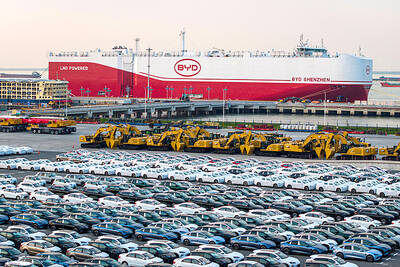US computer monitor vendors Dell Inc and Hewlett Packard Co (HP) and China's Lenovo Group (聯想) may lose market share in the first half of the year after a major fire halted production lines at Lite-On Technology Corp (光寶科技), a major supplier, market researcher DisplaySearch said in its latest report.
The blaze could have a major impact on the landscape of the desktop liquid-crystal-display (LCD) monitor industry in the first and second quarters in terms of share-shift, rather than improving the balance between supply and demand, the Austin, Texas-based researcher said in the report released on Friday.
"Brands such as Dell, HP and Lenovo could be impacted the most," DisplaySearch said.
Dell and HP ranked second and third globally in terms of LCD monitor sales, tracking behind Samsung Electronics Co, DisplaySearch said.
In a statement filed with the Taiwan Stock Exchange last week, Lite-On, the world's fifth-biggest contract manufacturer of LCD monitors, said a fire broke out on Feb. 3 at a factory in southeastern China, damaging 14 PC monitor production lines.
There was no damage to LCD TV screen production lines, it said.
Approximately one-fifth of LCD monitors sold by Dell, HP and Lenovo are manufactured by Lite-On, DisplaySearch said in an LCD monitor report in the third quarter of last year.
Dell has been losing market share to stand-alone monitor brand Samsung over the past few quarters and a disaster such as this could cut their share further in the coming months, DisplaySearch said.
The impact could be the most severe in the North American market, where Dell accounts for approximately 30 percent of monitor imports, it said.
Financial impact on Dell may not be that severe, but Dell could lose market share to brands that do not rely on Lite-On, the researcher said.
LG Electronics Inc and Taiwan's Acer Inc ranked No. 4 and No. 5 respectively, in terms of LCD monitor sales, DisplaySearch said.
Last week, Lite-On said it would temporarily convert part of its LCD TV screen production lines to make PC monitors during the traditionally slack season. The company said inventories would meet demand in the next one to two months.
No employees were hurt during the fire, Lite-On said in the statement. Lite-On said it has filed a damages claim with Ping An Insurer (Group) Co of China (
Shares of Lite-On closed at NT$47.35, up 0.74 percent, on Feb. 1, the last trading session of the local bourse before the Lunar New Year holidays.
The stock market is scheduled to reopen tomorrow.

Micron Memory Taiwan Co (台灣美光), a subsidiary of US memorychip maker Micron Technology Inc, has been granted a NT$4.7 billion (US$149.5 million) subsidy under the Ministry of Economic Affairs A+ Corporate Innovation and R&D Enhancement program, the ministry said yesterday. The US memorychip maker’s program aims to back the development of high-performance and high-bandwidth memory chips with a total budget of NT$11.75 billion, the ministry said. Aside from the government funding, Micron is to inject the remaining investment of NT$7.06 billion as the company applied to participate the government’s Global Innovation Partnership Program to deepen technology cooperation, a ministry official told the

Taiwan Semiconductor Manufacturing Co (TSMC, 台積電), the world’s leading advanced chipmaker, officially began volume production of its 2-nanometer chips in the fourth quarter of this year, according to a recent update on the company’s Web site. The low-key announcement confirms that TSMC, the go-to chipmaker for artificial intelligence (AI) hardware providers Nvidia Corp and iPhone maker Apple Inc, met its original roadmap for the next-generation technology. Production is currently centered at Fab 22 in Kaohsiung, utilizing the company’s first-generation nanosheet transistor technology. The new architecture achieves “full-node strides in performance and power consumption,” TSMC said. The company described the 2nm process as

POTENTIAL demand: Tesla’s chance of reclaiming its leadership in EVs seems uncertain, but breakthrough in full self-driving could help boost sales, an analyst said Chinese auto giant BYD Co (比亞迪) is poised to surpass Tesla Inc as the world’s biggest electric vehicle (EV) company in annual sales. The two groups are expected to soon publish their final figures for this year, and based on sales data so far this year, there is almost no chance the US company led by CEO Elon Musk would retain its leadership position. As of the end of last month, BYD, which also produces hybrid vehicles, had sold 2.07 million EVs. Tesla, for its part, had sold 1.22 million by the end of September. Tesla’s September figures included a one-time boost in

Shares in Taiwan closed at a new high yesterday, the first trading day of the new year, as contract chipmaker Taiwan Semiconductor Manufacturing Co (TSMC, 台積電) continued to break records amid an artificial intelligence (AI) boom, dealers said. The TAIEX closed up 386.21 points, or 1.33 percent, at 29,349.81, with turnover totaling NT$648.844 billion (US$20.65 billion). “Judging from a stronger Taiwan dollar against the US dollar, I think foreign institutional investors returned from the holidays and brought funds into the local market,” Concord Securities Co (康和證券) analyst Kerry Huang (黃志祺) said. “Foreign investors just rebuilt their positions with TSMC as their top target,